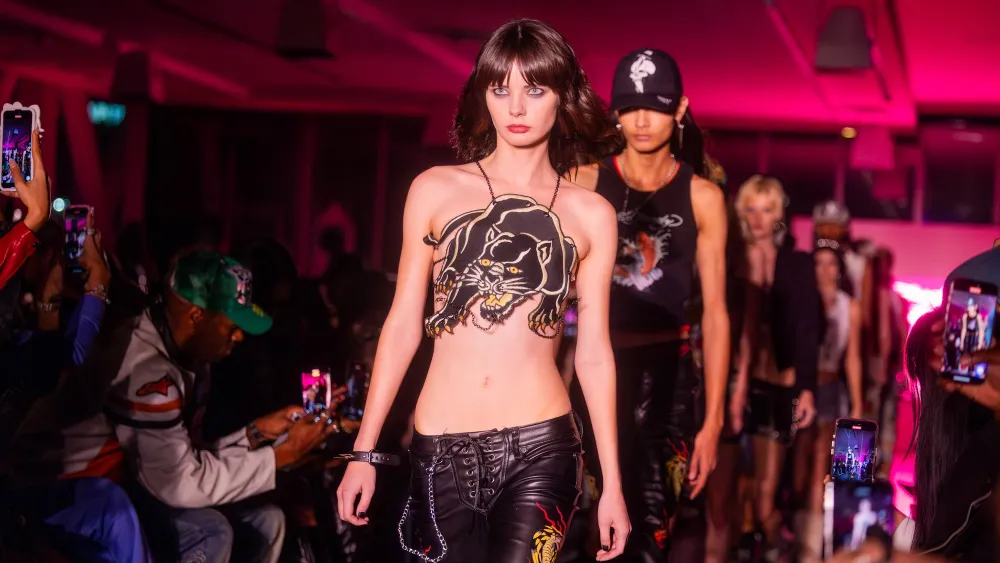Introduction to Ed Hardy
Few names in the fashion world evoke as strong and controversial a reaction as Ed Hardy. Once hailed as the epitome of edgy, rebellious streetwear in the early 2000s, the brand surged to popularity almost overnight — only to fall out of fashion just as rapidly. Backed by the flamboyant marketing genius of Christian Audigier and inspired by the intricate tattoo art of Don Ed Hardy, the Ed Hardy brand became both a fashion powerhouse and a cautionary tale of overexposure and brand dilution.
The Roots Who Is Don Ed Hardy?
To understand Ed Hardy the brand, we must first appreciate Don Ed Hardy, the man.
Born in 1945 in Southern California, Don Ed Hardy was fascinated by tattoos from an early age. After graduating with a BFA in printmaking from the San Francisco Art Institute in 1967, Hardy chose an unconventional path: tattooing. At a time when tattoos were still associated with bikers and the military, Hardy elevated the craft into an art form.
He is widely credited with pioneering custom tattooing, where each piece is created specifically for the client rather than chosen from flash art on a wall. More importantly, Hardy was heavily influenced by Japanese tattoo aesthetics, having studied under the legendary Japanese tattoo master Horihide. He seamlessly blended American and Japanese styles, creating a visual language that would later become the foundation for the Ed Hardy fashion line.
By the late 1990s, Hardy had already built a solid reputation as an innovator in the tattoo world. His artwork had been displayed in galleries and published in books, gaining appreciation from both tattoo enthusiasts and fine art communities.
The Birth of the Ed Hardy Brand

The transformation from tattoo artist to fashion icon began when Christian Audigier, a French designer known for his work with brands like Von Dutch, approached Hardy in the early 2000s.
Audigier licensed the rights to Hardy’s art in 2003 and quickly turned it into a global fashion brand. With a sharp eye for marketing and celebrity endorsements, Audigier infused Ed Hardy apparel with glitzy, rhinestone-studded designs that were flashy, rebellious, and unapologetically bold. T-shirts, hoodies, trucker hats, jeans, and even sneakers became canvases for Hardy’s iconic imagery: skulls, tigers, eagles, and koi fish with bold typography and tattoo-style flourishes.
Within a few short years, Ed Hardy became a cultural phenomenon, embraced by celebrities like Madonna, Britney Spears, David Beckham, and Paris Hilton. The brand symbolized a particular kind of 2000s glam-rock lifestyle — sexy, flashy, and defiantly non-conformist.
The Peak Global Domination
At its height, Ed Hardy was a $700 million brand, sold in over 50 countries with hundreds of retail locations. Christian Audigier used his experience with Von Dutch to great effect, turning Hardy into a lifestyle brand rather than just a fashion label.
This strategy involved:
- Aggressive celebrity marketing
- Limited-edition drops
- Luxury pricing
- Expansion into accessories, fragrances, and home goods
The brand was everywhere — music videos, red carpet events, nightclubs, and even reality TV shows. It had tapped into a cultural zeitgeist, capturing the energy of early 2000s pop culture and merging it with tattoo subculture.
The Fall Oversaturation and Backlash
However, what goes up must come down — and Ed Hardy fell hard.
By 2010, the brand had become synonymous with gaudy, over-the-top fashion. Critics accused it of being tacky and emblematic of style without substance. Overexposure was one of the key culprits. You could find Ed Hardy not only in upscale boutiques but also in discount department stores and unauthorized knockoffs — a clear sign of brand dilution.
Worse, the brand was being associated with “douchebag culture”, a stereotype made popular by TV shows like Jersey Shore. The once-celebrated designs were now ridiculed, and wearing Ed Hardy became almost a fashion faux pas. Celebrities who had once flaunted the brand began to distance themselves from it.
Even Don Ed Hardy himself later expressed regret about how his name was commercialized, stating in interviews that he had lost creative control over the brand’s direction.
The Business Struggles
Behind the scenes, the brand was facing financial and legal troubles. Licensing disputes and lawsuits between Hardy, Audigier, and the parent company, Iconix Brand Group, further complicated the picture.
In 2011, Christian Audigier exited the company, and Hardy was left with a tarnished image. Sales plummeted. Many Ed Hardy stores shut down, and the brand all but disappeared from the mainstream fashion conversation.
The Reinvention Can Ed Hardy Make a Comeback?
The past decade has seen several attempts to revive and reinvent Hardy, banking on the cyclical nature of fashion. In recent years, nostalgia for 2000s fashion — often dubbed “Y2K aesthetic” — has brought back trucker hats, bedazzled shirts, and yes, even Ed Hardy.
New collections have been launched with more refined, minimalist versions of the original designs. Fashion retailers like Urban Outfitters and ASOS have reintroduced vintage Ed Hardy styles, and younger consumers, who view the brand through a retro lens, are embracing it ironically or affectionately.
Additionally, collaborations with contemporary designers and influencers have helped reframe Hardy as part of a larger cultural comeback.
What’s different this time is a more curated brand strategy, with tighter control over licensing, distribution, and creative direction. There’s an acknowledgment of past mistakes — and an attempt to reintroduce the brand without the over-the-top glitz that made it infamous.
Legacy More Than Just a Fashion Trend
While Ed Hardy’s fashion brand might be best known for its flashy highs and meme-worthy lows, it’s important to remember the deeper legacy.
- Don Ed Hardy helped bring tattoo culture into mainstream respectability.
- His art blurred the lines between commercial design and fine art, decades before streetwear brands like Supreme or Off-White made that cool.
- The Ed Hardy brand helped pioneer the now-ubiquitous trend of tattoo-inspired fashion.
Furthermore, it sparked conversations about authenticity, brand management, and the risks of over-commercialization.
Final Thoughts
The story of Ed Hardy is one of creativity, excess, downfall, and resilience. It’s a classic tale of what happens when underground culture meets mass-market ambition. While its rise and fall are etched in early 2000s history, its impact on fashion, branding, and pop culture continues to resonate.
As the fashion world becomes increasingly nostalgic and inclusive of alternative styles, the time might be ripe for Ed Hardy to write a new chapter — one that honors its roots while avoiding the pitfalls of its past.
After all, just like a great tattoo, some things are worth preserving — even if their time in the spotlight has faded.
You Many Also Read: Peplum tops


